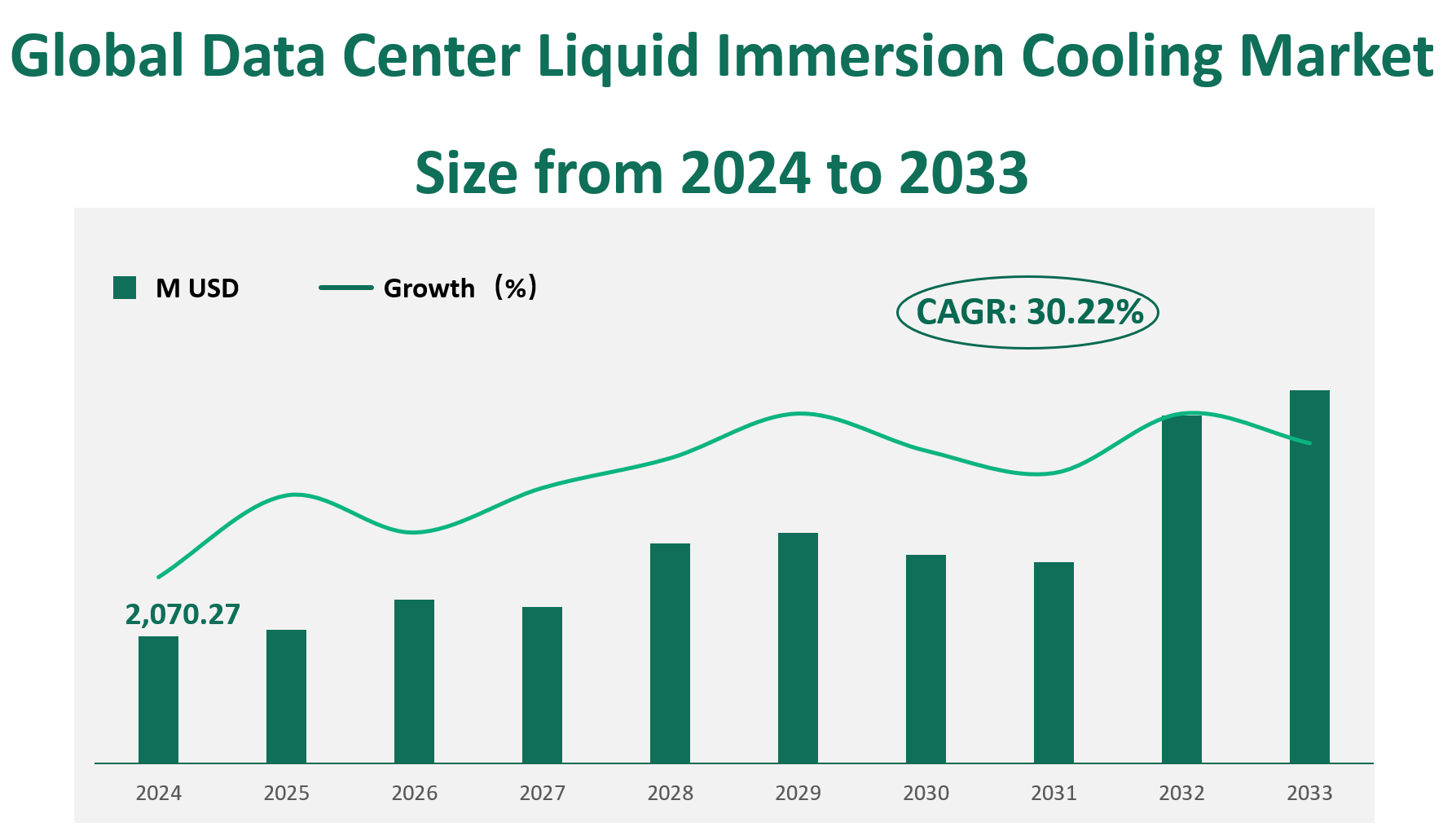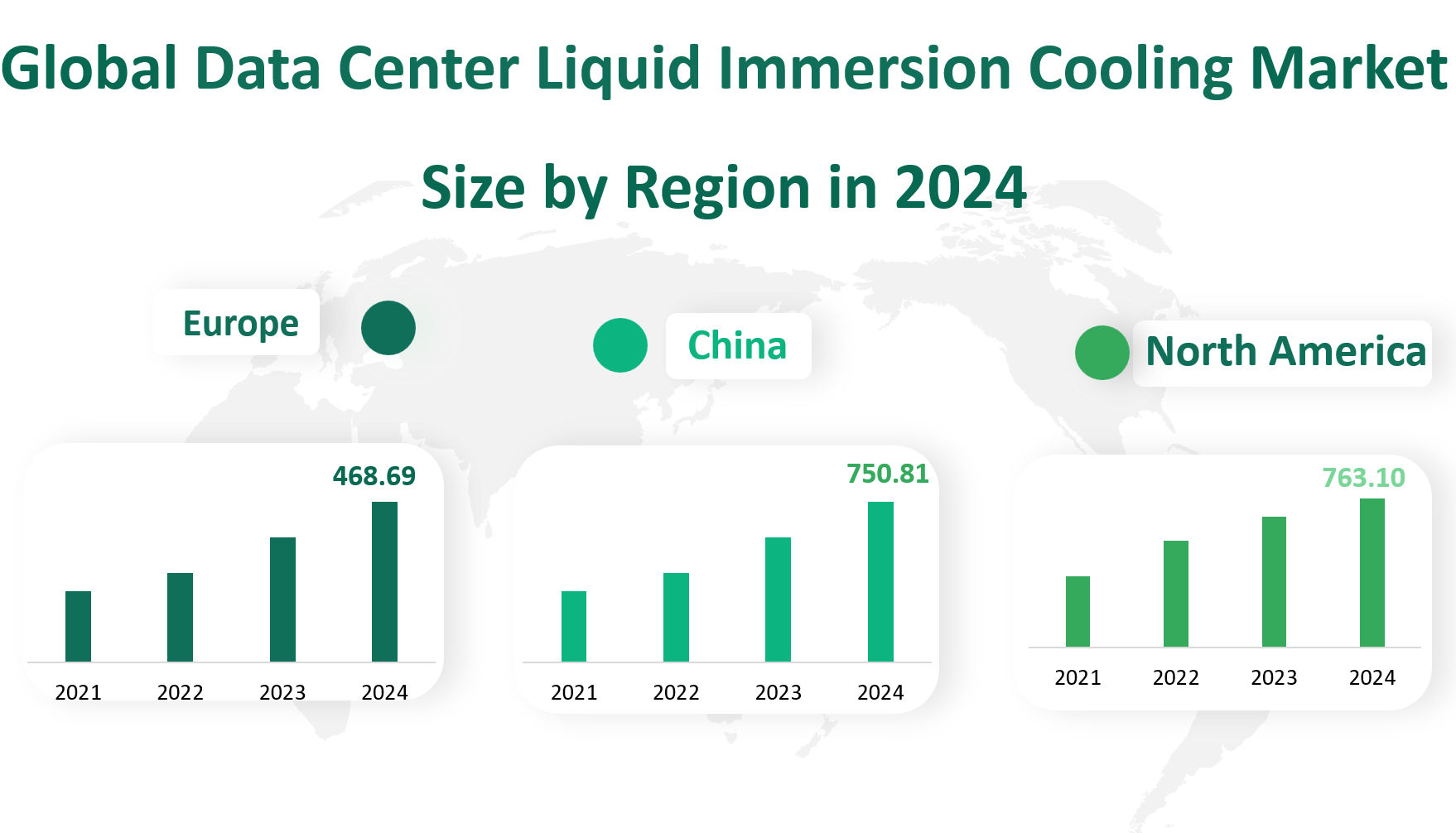1. Global Data Center Liquid Immersion Cooling Market Insight Analysis
In 2024, the global Data Center Liquid Immersion Cooling market revenue reached 2,070.27 million USD, with a Compound Annual Growth Rate (CAGR) of 30.22% from 2024 to 2033.
Data Center Liquid Immersion Cooling is a revolutionary technology designed to address the thermal management challenges faced by modern data centers. Unlike traditional air cooling systems, liquid immersion cooling involves submerging servers and other IT equipment in a non-conductive liquid coolant.
This coolant, often a specialized dielectric fluid, efficiently absorbs and dissipates heat, allowing data centers to operate at higher densities while significantly reducing energy consumption. The process not only enhances cooling efficiency but also minimizes the environmental impact by reducing the need for large-scale air conditioning systems. As data centers continue to grow in size and complexity, liquid immersion cooling is becoming an essential solution for maintaining optimal operating temperatures and ensuring the reliability of critical IT infrastructure.
Figure Global Data Center Liquid Immersion Cooling Market Size (M USD) and CAGR (2024-2033)

2. Driving and Limiting Factors of Data Center Liquid Immersion Cooling Market Growth
The growth of the Data Center Liquid Immersion Cooling market is driven by several key factors. Firstly, the increasing demand for high-performance computing (HPC) and artificial intelligence (AI) applications has led to a surge in the number of data centers worldwide. These facilities require advanced cooling solutions to manage the intense heat generated by high-density servers. Liquid immersion cooling offers a highly efficient and scalable solution, making it an attractive option for data center operators.
Secondly, the environmental benefits of liquid immersion cooling are driving its adoption. Traditional air cooling systems consume significant amounts of energy, contributing to high operational costs and carbon emissions. In contrast, liquid immersion cooling systems are more energy-efficient and can reduce cooling-related energy consumption by up to 90%. This makes them an ideal choice for companies looking to reduce their carbon footprint and meet sustainability goals.
However, the market also faces several limiting factors. One of the primary challenges is the high initial investment required for liquid immersion cooling systems. The cost of specialized coolant fluids, system installation, and maintenance can be prohibitive for smaller data centers and organizations. Additionally, the complexity of integrating liquid immersion cooling systems with existing infrastructure can pose technical challenges, requiring specialized expertise and resources.
Another limiting factor is the potential environmental and health risks associated with the use of certain coolant fluids. Some dielectric fluids may have negative environmental impacts if not properly managed, and prolonged exposure to certain coolants can pose health risks to data center staff. These concerns may slow the adoption of liquid immersion cooling in some regions.
3. Technology Innovation and Corporate Mergers and Acquisitions in Data Center Liquid Immersion Cooling Market
The Data Center Liquid Immersion Cooling market is characterized by continuous technological innovation and strategic corporate activities. Companies are constantly developing new and improved coolant fluids and cooling systems to enhance efficiency, reduce costs, and address environmental concerns. For example, 3M has developed advanced fluorocarbon-based fluids that offer superior thermal conductivity and low environmental impact. Similarly, Green Revolution Cooling has introduced innovative single-phase cooling systems that simplify installation and maintenance while maximizing cooling capacity.
Corporate mergers and acquisitions are also playing a significant role in shaping the market landscape. Major players are acquiring smaller companies to expand their product portfolios and gain access to new technologies. For instance, Fujitsu Limited has partnered with various technology providers to integrate liquid immersion cooling solutions into their data center offerings. These strategic alliances enable companies to leverage complementary technologies and expertise, accelerating the development and deployment of advanced cooling solutions.
Furthermore, the market is witnessing increased collaboration between data center operators, technology providers, and research institutions. These partnerships aim to drive innovation and address the challenges associated with liquid immersion cooling. For example, Submer Technologies has established a North American headquarters in Ashburn to better serve the growing demand for efficient cooling solutions in the region. Such initiatives are crucial for promoting the widespread adoption of liquid immersion cooling and ensuring its long-term success in the data center industry.
4. Global Data Center Liquid Immersion Cooling Market Size by Type
Data Center Liquid Immersion Cooling is a rapidly growing technology designed to address the increasing heat dissipation needs of modern data centers. This technology involves submerging servers and other IT equipment in a non-conductive liquid coolant to efficiently transfer heat away from the components. The market is primarily segmented into two types: Single Phase Cooling and Two Phase Cooling.
Single Phase Cooling is a method where the server components are submerged in a coolant that remains in a liquid state throughout the cooling process. The coolant, typically a hydrocarbon-based dielectric fluid, transfers heat directly from the components to the fluid without undergoing a phase change. This method is known for its simplicity, lower initial costs, and ease of operation. It is particularly suitable for applications where high-density computing is required but the heat load is manageable without the need for complex phase change mechanisms.
Single Phase Cooling is expected to generate a revenue of approximately $1,482.23 million in 2024. This type of cooling system is favored by many data centers due to its cost-effectiveness and simplicity, making it a popular choice for both small and medium-sized data centers as well as large-scale operations.
Two Phase Cooling, on the other hand, involves a phase change where the coolant transitions from a liquid to a gas state as it absorbs heat from the components. The coolant is typically a fluorocarbon-based liquid with a low boiling point, which allows it to evaporate and condense back into a liquid, creating a continuous cooling cycle. This method is highly efficient for high-performance computing environments where the heat load is extremely high. The market revenue for Two Phase Cooling in 2024 is forecasted to be around $588.04 million.
Table Global Data Center Liquid Immersion Cooling Market Size by Type in 2024
5. Global Data Center Liquid Immersion Cooling Market Size by Application
The Data Center Liquid Immersion Cooling market serves various applications, each with distinct requirements and market dynamics. The primary applications include Small and Medium Data Centers, Large Data Centers, and Hyper-Scale Data Centers.
Small and Medium Data Centers represent a significant portion of the Data Center Liquid Immersion Cooling market. These data centers typically serve businesses and organizations with moderate computing needs, ranging from small enterprises to mid-sized corporations. The primary advantage of liquid immersion cooling in these environments is the ability to achieve high-density computing with minimal space and energy requirements.
In 2024, the market revenue for Small and Medium Data Centers is projected to be around $1,088.78 million. This segment is driven by the growing demand for efficient and cost-effective cooling solutions that can handle the increasing computational loads without requiring extensive infrastructure upgrades. Liquid immersion cooling offers a scalable and flexible solution that can be easily integrated into existing data center designs, making it an attractive option for many businesses.
Large Data Centers are another critical application segment for Data Center Liquid Immersion Cooling. These facilities often support large-scale computing operations, including cloud services, enterprise data processing, and other intensive applications. The need for efficient cooling solutions is paramount in these environments to ensure optimal performance and reliability.
The market revenue for Large Data Centers in 2024 is forecasted to be approximately $830.44 million. The adoption of liquid immersion cooling in large data centers is driven by the need to manage high heat loads efficiently and reduce energy consumption. This technology allows data centers to achieve higher server densities and lower operational costs, making it a valuable solution for large-scale computing environments.
Hyper-Scale Data Centers represent the cutting-edge of data center technology, supporting massive computing operations such as artificial intelligence, machine learning, and other high-performance computing tasks. These facilities require highly efficient cooling solutions to manage the extreme heat generated by their high-density computing infrastructure.
In 2024, the market revenue for Hyper-Scale Data Centers is expected to be around $151.05 million. While this segment is smaller in terms of overall market revenue compared to Small and Medium Data Centers and Large Data Centers, it is growing rapidly due to the increasing demand for high-performance computing. Hyper-Scale Data Centers are often at the forefront of adopting advanced cooling technologies like liquid immersion cooling to ensure optimal performance and energy efficiency.
Table Global Data Center Liquid Immersion Cooling Market Size by Application in 2024
Application | Market Size (M USD) 2024 |
Small and Medium Data Centers | 1088.78 |
Large Data Centers | 830.44 |
Hyper-Scale Data Centers | 151.05 |
6. Global Data Center Liquid Immersion Cooling Market by Top Regions
North America remains the largest regional market by revenue, accounting for $763.10 million USD in 2024. This region’s dominance is attributed to the high concentration of data centers and advanced technological infrastructure in the United States and Canada. The presence of major technology companies and hyperscale data centers has driven the adoption of liquid immersion cooling solutions to manage the heat generated by high-density computing environments.
Asia-Pacific is the fastest-growing region, with a projected market revenue of $750.81 million USD in 2024. The rapid expansion of the digital economy in countries like China, Japan, and South Korea has led to a surge in data center construction. The region’s growing demand for high-performance computing (HPC) and artificial intelligence (AI) applications has necessitated advanced cooling solutions to manage the heat generated by these high-density systems.
Europe holds a significant share of the market, with a revenue of $468.69 million USD in 2024. The region’s focus on environmental regulations and sustainability has led to a growing interest in energy-efficient cooling solutions. The presence of major data centers and hyperscale facilities in countries like Germany, the UK, and France has driven the adoption of liquid immersion cooling technologies.
Middle East and Africa and South America are emerging markets with significant growth potential. In 2024, the Middle East and Africa market is projected to reach $47.51 million USD, while South America is expected to generate $40.16 million USD in revenue. These regions are experiencing rapid digital transformation, leading to increased demand for data centers and advanced cooling solutions.
Figure Global Data Center Liquid Immersion Cooling Market Size by Region in 2024

7. Global Data Center Liquid Immersion Cooling Market Analysis by Major Players
7.1 3M
Introduction and Business Overview:
3M is a global leader in diverse technologies and products, with a strong presence in the electronics, telecommunications, industrial, consumer, and healthcare markets. Established in 1902, the company operates worldwide and is renowned for its innovative solutions and high-quality products.
Products Offered:
3M offers advanced liquid immersion cooling solutions, including 3M™ Fluorinert™ Electronic Liquids and 3M™ Novec™ Engineered Fluids. These non-conductive coolants are designed to efficiently transfer heat from IT hardware, reducing the need for active cooling components and significantly lowering energy consumption.
7.2 Fujitsu Limited
Introduction and Business Overview:
Fujitsu Limited is a multinational information technology company, offering comprehensive IT development, network solutions, and telecommunications services. Established in 1935, Fujitsu operates globally and is known for its cutting-edge technology and commitment to sustainability.
Products Offered:
Fujitsu provides advanced liquid immersion cooling systems designed to reduce power consumption and increase server density. Their solutions are particularly effective in large-scale data centers, offering significant energy savings and improved cooling efficiency.
7.3 Green Revolution Cooling Inc.
Introduction and Business Overview:
Green Revolution Cooling (GRC) is a pioneering company in the field of liquid immersion cooling, founded in 2009 with the vision of revolutionizing data center design and operation. The company specializes in creating energy-efficient cooling solutions for data centers and cloud service providers.
Products Offered:
GRC offers single-phase immersion cooling systems, such as the ICEraQ™ platform, which can handle high-density computing environments with minimal energy consumption. Their solutions are designed to be scalable and highly efficient, making them ideal for modern data centers.

